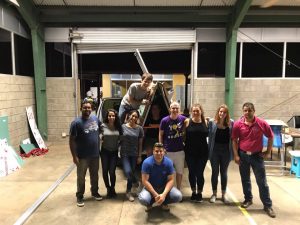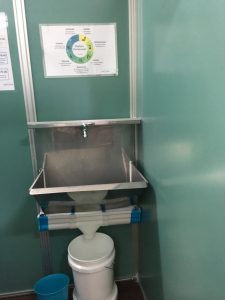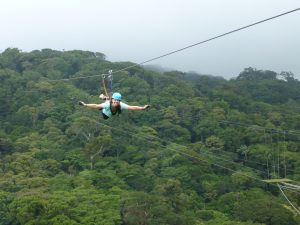Before arriving in Costa Rica, several people warned us about all of the bugs, but I managed to leave the Central Valley after a week and a half without a single bite, which made me think that those people didn’t know what they were talking about.
Boy, was I wrong.
Since arriving in Guanacaste two weeks ago, I’ve found upwards of 30 mosquito bites on my ankles, arms, legs, and even one on my face. Maybe I need to buy different bug spray, or maybe the bugs sense us gringos (what Costa Ricans call foreigners) and our fear.
Besides being delicious to the bugs, we learned and accomplished several other things this last week:
- We finished our prototype for the DialOasis project with the Invenio team using only local materials
- We obtained patient and physician feedback at Hospital Liberia
- We maintained communication among the team, despite working on different tasks
- I have learned several new words and phrases in Spanish, thanks to my fellow GMIers
- This group makes everything fun, demonstrated by our constant laughter at anything and everything
- We are incredibly efficient as a group when it comes to ordering pizza after a 10-hour day
At the end of last week, we divided our group of 8 into three teams for the DialOasis implementation project and created a work breakdown structure. I was on the materials team with Callie and Anna, and we were responsible for searching for local materials that could be utilized in our prototype for Friday, as well as materials that had potential for use in order to reduce the cost of the cuartito (“tiny house”). For those that are not caught up on the project, the cuartito is the small room we are trying to build for peritoneal dialysis patients to perform their procedures at home.
Packing up the cuartito with the Invenio team
Callie, Anna, and I spent the majority of the week searching through hardware and grocery stores for items that could be useful for the project. We compiled a list of all of the items we found with pictures, dimensions, and prices that we then presented to the build team. Based on what we found and what the build team had designed, we were able to determine which materials would work best. Thankfully, Dr. Richardson went to the hardware store with us when it came time to start purchasing materials. He was able to help us determine the parts we would need for the faucet and plumbing, which was really helpful considering we didn’t have much experience with that aspect of the project, but the best part was that he ultimately left the decisions up to us. He continuously asked us what we thought was best, answered our questions and listened to our concerns, and gave his recommendations to help us determine the best solutions.
Once we finished acquiring all of the materials, we handed them over to the build team to begin building the various components of the cuartito. The materials team was also responsible for doing a labor, burden, and materials (LBM) analysis for the prototype and looking for areas to reduce cost. We were able to complete a large portion of the LBM throughout the second half of the week, but we are waiting on some prices from Invenio in order to complete our analysis. As of now, our prototype will likely cost around $1,000, and our goal is to reduce the price to under $500, which will be a significant—but feasible—challenge.
Throughout the week, there were many experiences that proved challenging. As we were creating our work breakdown structure, Dr. Richardson told us that “plans never work, but planning does,” and he was absolutely right (I’m pretty sure he always is). We determined all of the tasks that needed done, as well as the components that went into the tasks, in order to complete the project on time while meeting our goal of creating a functional prototype to test with patients and physicians in order to get constructive feedback. As you probably could have guessed, our plan did not work with the timeline we had set for ourselves. Transportation was tricky and a few of the design aspects proved to take longer than expected.
Between all three teams—materials, building, and testing—we all needed to be in different places at the same time, which was nearly impossible considering there is only one Dr. Richardson. Many of us determined the best solution would be to clone him. Just kidding (kind of)! At first, it seemed that this would stall our progress, but it turned out that we were able to adjust our time fairly well in order to still be productive and continue making progress. In between trips to the hardware stores, we spent a lot of time organizing our findings, making lists of what we still needed to find and dividing up tasks, determining what materials or design aspects could be changed in order to reduce cost, working with the testing team to bounce ideas off of each other for both materials selection and questions to ask patients for feedback, and providing extra hands for the build team when necessary. What seemed like a problem in the beginning, actually proved to be quite helpful in encouraging communication among the three teams.
The design and fabrication of the sink ended up being more challenging than we had originally thought. The team decided to use sheet metal to create their own sink, and stainless steel was the metal of choice. The machine they had to use to bend the metal was fairly difficult to work with, as it kept getting stuck when they tried removing the metal. This led to a much longer fabrication process than expected, and it also left the materials and testing teams with a good bit of down time since we had finished our tasks and were unable to help with any of the other building components. We were going to work on framing the door, but the Invenio engineers felt more comfortable doing it themselves, which I definitely understand. I found this down time to be a bit frustrating, mostly because I enjoy being busy and wanted to help move the project forward, but there wasn’t much we could do until the sink was finished. Fortunately, we were able to find other small tasks to do to keep us busy, and we spent a good bit of time discussing what worked well and what we could have done differently.
Overall, this week was a great learning experience. I have always been one to plan ten steps ahead and stick to my plan, so this week was a challenge for me, but it has taught me that things don’t always go as planned and it’s important to be flexible. As I found myself getting frustrated over the week, I tried to remind myself to keep a positive mindset. I also gained a greater appreciation for maintaining communication among different teams working on the same project. One of the aspects of my capstone experience last year that was the most frustrating was the lack of communication between some of my group members, so having worked with a group that was willing to listen to one another’s opinions and ideas and communicate their plans was a huge plus from this week.
Testing the cuartito with patients, nurses, and physicians on Friday gave us a lot of good feedback on what they liked and what should be changed, which will be implemented by one or two of the GMI students during the school year (we each get an implementation project). I really enjoyed experiencing the excitement of all of the people in the dialysis unit as they saw our prototype. It definitely made the long hours worth it.
The conclusion of this project was the end of our time in Guanacaste. Yesterday, we packed up and headed back to San Jose, Santa Ana to be specific, but we stopped at Monteverde on the way to go zip-lining. Dr. Richardson had mentioned to Anna and me that it would be “spectacular,” and it was nothing short. We got to do 7 regular zip-lines, 2 superman zip-lines, and a mega Tarzan swing (thanks for talking me into it, Tasha). Breaking through the trees on the first superman line was one of the most incredible experiences I have ever had.
Today, we will be relaxing and exploring Santa Ana before our next short course begins. Pura Vida!





